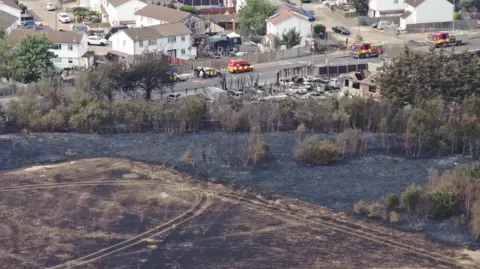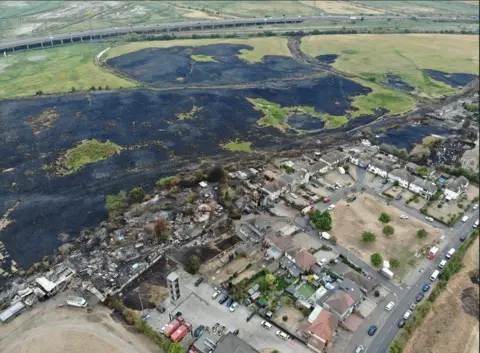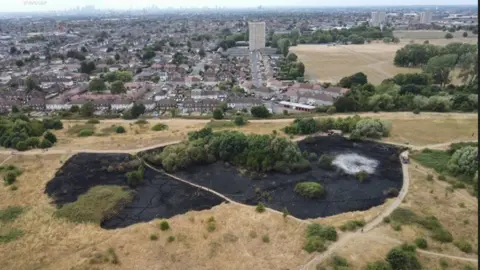Scientists look into London's 2022 'firewaves'
 London Fire Brigade
London Fire BrigadeScientists at Imperial College have found that a wave of fires in London in 2022 may have been caused by high levels of a physical property called vapour pressure deficit (VPD).
Their research suggests that VPD may have been most directly responsible for the London Fire Brigade's busiest day since World War Two - and indicates that using this measure could predict where wild fires are likely to occur.
Fire scientist Professor Guillermo Rein said he and researcher Jamie John conducted the Heatwaves and Firewaves study, which is yet to be peer-reviewed, because of their "worry" about the unusually high number of fires in the capital two years ago.
London Fire Brigade (LFB) said climate change would "continue to give rise to more extreme weather events" and research that strives to explain its impact was "valuable".
 LFB
LFBAccording to London Mayor Sadiq Khan, the LFB dealt with 2,600 calls on 19 July 2022 – the daily average is 350 - and 41 London properties were destroyed by fire.
The study into heatwaves and firewaves - a period containing an unusually high number of fires - describes itself as a first attempt to quantify the links between heatwaves and wildfires in a city.
Researchers analysed 13 years' worth of data from LFB and the Met Office.
Their report identified five London firewaves between 2009 and 2022, one in 2018 and four in 2022.
VPD - a measure of the atmosphere’s ability to extract moisture from the land surface - was found to be the most direct cause of wildfires in an urban environment followed by relative humidity and maximum daily temperature.
The report said: "We see potential for it to be used as part of an early-warning framework for wildfires in London.
"VPD is measurable, though it is not currently recorded by the UK’s Met Office. The Met Office does, however, record relative humidity and temperature.
"If humidity and temperature forecasts can be obtained, VPD can itself be forecast.
"If forecasts show that the VPD metric is met or likely to be exceeded, fire brigades can be put on higher alert, allowing for a degree of preparation that would otherwise not be possible."
It added: "This work poses important questions beyond London. Are other cities in the UK, Europe and the world at risk of or already suffering from urban wildfires and firewaves?"
'Forecasting method'
Professor Rein, who usually studies wildfires much further afield, said the study had three uses.
"First, to raise awareness in London of this extreme event that has happened before and will probably happen again," he said.
"Second, the best use of our forecasting method is for authorities and emergency services to know ahead of time when a heatwave may turn into a firewave.
"And third, it is likely that London is not the only city suffering the new hazard of firewaves. We want to raise awareness of them in the international community.
"We also hope that environmental campaigners will find this study useful."
 LFB
LFBA spokesperson for London Fire Brigade said: "The threat of wildfires is a global issue and London provides one of the most challenging urban environments in the world for a fire and rescue service.
"Along with the built environment, there are complex, dynamic and rapidly evolving risks.
"This includes areas of open grassland and vegetation that are vulnerable to wildfire, especially where it backs onto properties – something we saw having a devastating effect during the heatwave of 2022.
"Climate change will continue to give rise to more extreme weather events and we are planning for hotter summers over the coming years.
"Tackling the climate emergency is a collective effort. Research that strives to explain its impact on our communities and the environment is valuable."
Listen to the best of BBC Radio London on Sounds and follow BBC London on Facebook, X and Instagram. Send your story ideas to [email protected]
